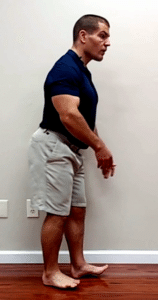Having strong ankles is important regardless of whether or not you've had an ankle sprain. Your ankle affects the biomechanics of your entire leg, so everyone should have at least a decent amount of strength and stability in their ankles.
Watch the video to learn 3 simple strengthening exercises for ankle stability and balance that you can start doing today without needing any equipment.

Ankle Strengthening Exercise #1
The most common strengthening exercise for the ankle that people think of is the calf raise or a heel raise. That's a great exercise, and it's a good starting point. However, many people do calf raises wrong.
Double Leg Heel Raise Exercise
When you do a heel raise, your Achilles tendons should stay straight up and down.
You shouldn't roll kind of to the outer sides of your foot.
You also shouldn't roll to the inner side of your foot.
So again when doing calf strengthening exercises for your ankle, you want to keep your Achilles aligned neutral.
Your Achilles tendon has tremendous strength resisting forces that are aligned along it, but too much side-to-side movement over time can put you at risk for an Achilles tendon injury.
Additionally, keeping your heel neutral when doing heel raises strengthens not only your calves but also your ankle invertor and ankle evertor muscles.
These muscles help you to control pronation and supination of your foot as you're going about your daily activities.
Up on 2, Down on 1
When you're able to do 20 heel raises to a full height, the next step is to progress from two legs to one leg.
Go up on your toes on 2 legs and come down on one leg.
When you can do that for 20 repetitions, then the next step after that is just doing one leg heel raises.
Single Leg Heel Raise
Now, this is where the balance aspect really comes in.
Remember to keep your Achilles neutral without letting your ankle roll inwards or outwards.
Try to get to full height on each repetition.
So, that's the first exercise to help strengthen your ankle.
Ankle Strengthening Exercise #2
The second exercise is to maintain your balance.
A lot of people will do resistance band exercises where they turn their ankle in and out.
However, that's not functionally how we use our invertor muscles (tibialis posterior) and the evertor muscles (fibularis longus and fibularis brevis).
The way that you functionally use your inverters and inverter muscles is to control pronation and supination when you're walking.
So just practicing balancing on one foot helps strengthen your ankle by using those muscles at the same time to help counterbalance each other while you're balancing on one foot.
Start out by lifting your arch.
In order to do this, you may need to put your weight a little more on the outer side of your foot than you're used to. Additionally, think about gripping the ground with your toes.
Then keep your arch lifted while maintaining your balance.
If you need to, you can hold onto a wall or a piece of furniture to help you keep the arch and maintain your balance.
If this is your first time doing this exercise, I would highly recommend holding on to something for safety. Then, as your balance gets better, you can let go.
So, that's the second ankle strengthening exercise.
Ankle Strengthening Exercise #3
The third strengthening exercise for your ankle is one that people don't think about quite as much.
Namely, it helps you lift your foot up so that you don't catch your toes on the floor as you swing your leg through.
That's important so that you don't trip over your toes and fall when you're walking.
The muscle that lifts your foot is called the tibialis anterior.
That's the muscle that gets weak when someone has foot drag or drop foot.
A functional strengthening exercise for your tibialis anterior is to practice walking on your heels and keeping your toes lifted.
If you don't quite have the strength or balance to start out doing that right away, you can start out standing against the wall and just lifting your toes up.
Then, as you get stronger and develop better balance, you can turn that into a more dynamic exercise of doing heel walks.
Conclusion
So those were three strengthening exercises for ankle stability and balance. Hopefully these exercises will help you be able to do your daily activities and/or exercise without putting stresses on your foot, ankle, knee, or hip due to poor biomechanics.
If you need more help to improve your balance or stability, or to relieve pain, tap the button below to request an appointment with one of our specialist physical therapists.
Like this post? Here are some other related posts you might enjoy:
How Long Does An Ankle Sprain Take To Heal?
3 Best Balance Exercises For Seniors To Improve Balance At Home
















